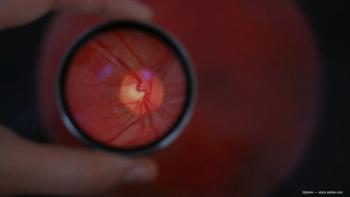
Imaging for Horner syndrome: Balancing cost with diagnostic accuracy
A single contrast-enhanced brain magnetic resonance imaging extending to the level of T2 in the chest and pharmacologic confirmation without localization seems appropriate to identify lesions in patients with Horner syndrome.
Reviewed by Ying Chen, BS, and Andrew G. Lee, MD
Houston-While Horner syndrome itself is uncommon, the life-threatening aspect of the condition demands immediate attention when a patient presents acutely with ipsilateral miosis, ptosis, and anhidrosis resulting from a lesion in the oculosympathetic pathway.
However, there is no current consensus on the best way to ferret out the underlying etiology.
The conventional approach to evaluating a patient with Horner syndrome has been a clinical and pharmacologic assessment with localization of the lesion. Multimodal testing can be the last step in the process, but searches of the current literature show literature lack of consensus on the type of imaging as well as its cost and diagnostic yield, according to Ying Chen, BS.
Related:
To discern the importance of imaging in this patient population, Chen designed a study to determine the efficacy, safety, and cost-effectiveness of an imaging protocol. Chen is a medical student going into ophthalmology who will be graduating from Baylor College of Medicine, Houston.
Chen and her associates evaluated patients with Horner syndrome with a single contrast-enhanced head and neck magnetic resonance imaging (MRI) that extending to the thoracic T2 level. The investigators then compared this protocol with others already published.
Recent:
They first retrospectively reviewed all patients who received a causative or idiopathic diagnosis of Horner syndrome in their institution between 2010 and 2013. All patients underwent a single contrast-enhanced MRI of the brain that extended to T2.
However, in acute cases, the patients underwent computed tomography (CT) or CT angiography (CTA) of the head and neck. The investigators then evaluated the efficacy and cost-effectiveness of this method, Chen noted.
Related:
She reported that of the 34 patients identified with Horner syndrome, 27 were included in the study. In 11 patients the Horner syndrome was secondary to a proven cause, and in 16 patients no cause was identified. The cost of this protocol based on Medicare reimbursements in 2014 was estimated to be $667.76 without magnetic resonance angiography (MRA) and $1,501.71 with MRA.
The investigators published their findings (Canadian Journal of Ophthalmology. 2015;50:107-111).
Comparison with other protocols
Chen compared the study under discussion with four imaging recommendations.
The first study by Davagnanam and colleagues (Eye. 2013;27:291-298) recommended that any imaging performed be based on neuronal localization, i.e., MRI for first-order neuronal locations and CTA for second- and third-order localization. In cases with no localizing signs or with an acute onset, they recommended that CTA be performed within 6 weeks. The costs reported in association with this approach were similar to the study of Chen and associates.
More neuro-ophthalmology:
A second study, that of Reede et al. (Neuroimag Clin N Am. 2008;18:369-385) recommended that pharmacologic localization be carried out first. The imaging protocol was the same as the one in the study of Davagnanam et al., with the exception that no imaging was done for third-order neuronal localization. The costs were similar to those discussed previously.
In the third study, Lee et al. (AJR. 2007;188:W74-W81) recommended that imaging should be based on a suspected etiology and not pharmacologic localization. These authors used CT to identify suspected lesions in the lungs, mediastinum, and neck and MRI for lesions in the brachial plexus or cervical spinal cord. In cases of postganglionic Horner syndrome, no imaging recommendation was provided. The costs were less than those reported in the previous studies.
Recent:
In the final study of 52 patients reported by Almog and coworkers (J Neuro-Ophthalmol. 2010;30:7-11), the imaging recommendations were based on examinations without specific etiologies (i.e., MRI of the head and neck and CT or MRI of the chest). For those cases with etiologies, MRI or CT was performed as appropriate. The costs reported in this study were higher than in Chen’s study because of the added MRI and CT images of the chest.
Making a recommendation
Based on the study findings, Chen recommended performing a single contrast head and neck MRI to the level of T2 in the chest for Horner syndrome.
“We no longer rely on pharmacologic localization before imaging and all patients received the same protocol,” she said.
Furthermore, she pointed out that all 27 patients in her study were found to have an etiology and patients with a negative MRI did not develop a new etiology during the follow-up period for Horner syndrome.
“Compared with other recommended protocols, ours was similar to or less expensive than the other protocols that we reviewed and was easier and simpler to order,” Chen concluded.
In summary, that protocol involves three steps:
· a clinical diagnosis of Horner syndrome,
· pharmacologic confirmation with no need for localization, and
· a single contrast-enhanced brain MRI extending to the level of T2 in the chest.
In an acute setting, CT of the head and neck is performed with CTA.
Andrew G. Lee, MD, summarized Chen’s research.
“Ms. Chen’s work on Horner syndrome supports our current clinical practice of performing a CT and CTA of the head and neck in the acute setting to exclude a carotid dissection and performing a single MRI and MRA of the head and neck down to the T2 level in the chest for chronic or subacute Horner syndrome cases,” said Dr. Lee, chairman of ophthalmology, Houston Methodist Hospital Blanton Eye Institute and professor of ophthalmology, neurology, and neurosurgery, Weill Cornell Medicine; clinical professor of ophthalmology, UTMB Galveston and UT MD Anderson Cancer Center, Houston; and adjunct professor of ophthalmology, Baylor College of Medicine, Houston, the University of Iowa Hospitals and Clinics, Iowa City, IA, and the University of Buffalo, The State University of New York.
“We make the diagnosis of Horner syndrome clinically and do not currently use the hydroxyamphetamine drops to pharmacologically localize or direct our neuroimaging study to the pre- or post-ganglionic oculosympathetic pathway,” he said. “This is a change in our previous practice where pharmacologic testing, localization, and directed imaging were performed.”
More:
Ying Chen, BS
Andrew G. Lee, MD
This article was adapted from Chen’s presentation at the 2015 meeting of the American Academy of Ophthalmology. Chen and Dr. Lee have no financial interest in the subject matter.
Newsletter
Don’t miss out—get Ophthalmology Times updates on the latest clinical advancements and expert interviews, straight to your inbox.








































